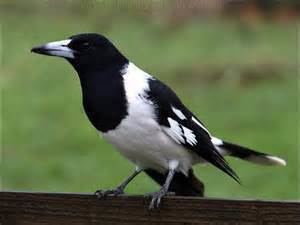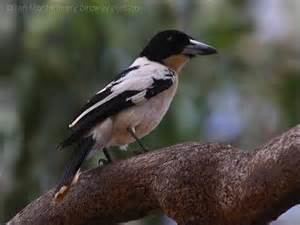Genus Cracticus Phylum Chordata Rank Species | Scientific name Cracticus cassicus Higher classification Butcherbird Order Passerine | |
 | ||
Similar Butcherbird, Bird, Peltops, Black butcherbird, Dwarf longbill | ||
Awesome bird the hooded butcherbird cracticus cassicus 7
The hooded butcherbird (Cracticus cassicus) is a species of passerine bird in the family Artamidae. It is found in New Guinea. Its natural habitat is subtropical or tropical moist lowland forests.
Contents
- Awesome bird the hooded butcherbird cracticus cassicus 7
- Burung jagal papua hooded butcherbird cracticus cassicus
- Taxonomy
- Description
- Distribution and habitat
- Behaviour
- References

Burung jagal papua hooded butcherbird cracticus cassicus
Taxonomy

The hooded butcherbird was first described by Dutch naturalist Pieter Boddaert in 1783, its specific epithet cassicus derived from the Latin "wearing a helmet" or "hood". It is one of six (or seven) members of the genus Cracticus known as butcherbirds. Within the genus, it is most closely related to the Tagula butcherbird, and the two are related to the pied butcherbird of Australia. The three form a monophyletic group within the genus, having diverged from ancestors of the grey butcherbird around five million years ago.

Two subspecies are recognised. The nominate race cassicus is found on mainland New Guinea and islands to the west, as well as Kairiru, Mushu and Basilaki Islands. The larger race hercules occurs on the D'entrecasteaux Archipelago and Trobriand Islands.
A local name in Ketengban is moro-moro.
Description

Measuring 32–35 cm in length, the male and female are similar in appearance. The plumage is predominantly black and white, the bird bearing a black head, nape and throat, white underparts, rump, and back, and black and white mantle. The tail is black, with a broad white tip. The robust pale bluish-grey bill is hooked and tipped black. The iris is black or dark brown, and the legs and feet are dark grey to black. It can be distinguished from the black-backed butcherbird by its black throat.

The hooded butcherbird has a complex fluting song, made up of many varied components. Birds may duet with each other, or mimic other species such as the rusty pitohui, little shrikethrush, spangled drongo, or helmeted friarbird.
Distribution and habitat

Found on New Guinea and surrounding islands, the hooded butcherbird inhabits forested country mainly in lowland areas to elevations of 650 m, or occasionally 1450 m. It is fairly common and may also be found close to human habitation in coconut groves.
Behaviour
The hooded butcherbird is carnivorous. Birds are found in pairs or small family groups.
Records indicate breeding may occur at any time. Located on a branch 8.5–25 m above ground, the nest is a bowl constructed of twigs and sticks. Two or three pale olive-brown or -green eggs are laid, blotched darker brown and measuring 31.8-35.6 x 23.7-25.6 mm.
